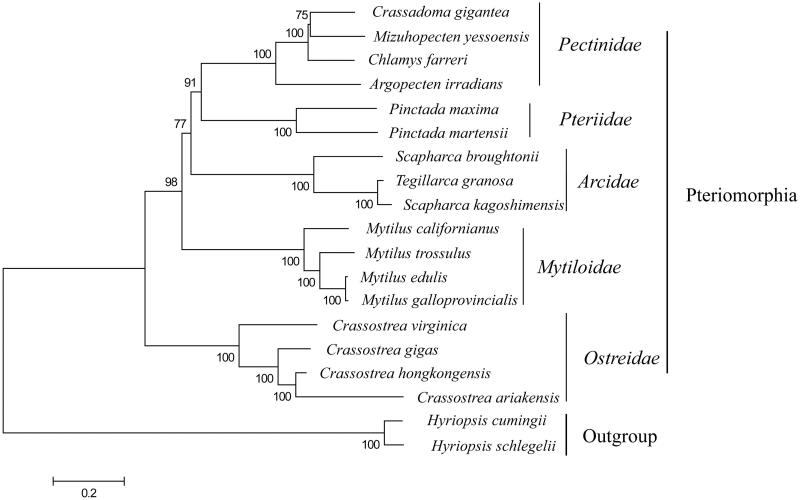Abstract
In this study, the complete 18,495 bp mitochondrial genome was determined from Rock scallop (Crassadoma gigantea) using next-generation sequencing technology. The complete mitochondrial genome contained 12 protein-coding genes (PCGs), 2 ribosomal RNA genes, 23 transfer RNA genes, without ATP8 and D-loop, which was similar with most mitochondrial genomes of marine bivalve molluscs. Gene annotations, including gene order, genetic code, start and stop codons and codons bias, were identified. Phylogenetic tree was constructed using Neighbor-Joining (NJ) method based on the PCGs showed the present species clustered within the Pteriomorphia clade. This work should be of importance not only for the better understanding of the relationships within Pectinidae, but also for the development of useful genetic markers in Rock scallop aquaculture and restoration efforts.
Keywords: Rock scallop, mitochondrial genome, phylogenetic relationship
Rock scallop (C. gigantea), which belongs to Mollusca, Lamellibranchia, Pterioida, was native to North America Pacific coast (Beitler et al. 1991). There are several valuable characteristics making rock scallop favored in the international market, including fast growth, strong resistance and delicious meat. The rock scallop was introduced to China to improve the stability and solve the problem of lacking varieties in scallop aquaculture. To date, the studies on rock scallops are mainly focused on physiology, ecology, production and aquaculture (MacDonald and Bourne 1989; Culver et al. 2000, 2006; Cao et al. 2017), while the genetics background was rarely reported. Here, the complete mitochondrial genome (mitogenome) of rock scallop was obtained by high-throughput sequencing using an Illumina HiSeq 2500 with paired-end 150 PE rapid run chemistry.
The specimen with 2 years old was collected from the Longwangtan, Bohai sea area (Dalian, Liaoning, China), which was derived from Vancouver, Canada. Similar to other bivalves, the mitochondrial genome of C. gigantea was a circular molecule with 18,495 bp in length and had been deposited in GenBank with accession number (MH016739). It contained 12 protein-coding genes (PCGs), 2 rRNAs, 23 tRNAs and non-coding regions (NCRs). Like most mitochondrial genomes of marine bivalve molluscs, the protein-coding gene ATP8 had not been identified in C. Gigantea. Within the whole mitochondrial genomes of C. gigantea, three largest non-coding regions were located between cox1 and nad4L (1173bp), cox2 and nad2 (637bp), and trnN-aac and trnV-gta (487bp), respectively. Furthermore, different start codons of protein-coding genes were identified by careful manual inspection, though they were highly biased towards ATG. For most genes, the stop codons (TAG) were identified relative completely.
The base compositions of the C. gigantea mitochondrial genome were A = 21.19%, C = 15.24%, G = 28.75%, and T = 34.82%, with an overall A + T content of 56.02%. To investigate the nucleotide bias, the AT and GC skews were calculated as (A-T)/(A + T) and (G-C)/(G + C), respectively (Puslednik et al. 2008). The AT and GC skews for the mitochondrial genome of C. gigantea were –0.243 and 0.309, respectively, indicating the occurrence of more G and T than C and A.
To future study the genetic relationship of C. gigantea with other scallops and the phylogenetic position in Pteriomorphia, additional 19 complete mitochondrial genomes were selected for phygenetic tree reconstruction, which were downloaded from GenBank database (Figure 1). Within Pteriomorphia, C. gigantea and Mizuhopecten yessoensis were in a clade sister to Chamys farreri, indicating a closer relationship between C. gigantea and M. yessoensis, which was similar with previous results revealed by short mitochondrial and nuclear gene fragments (Ballard et al. 2004).
Figure 1.
Neighbor Joining (NJ) trees based on the concatenated amino acid sequences of the PCGs.
Disclosure statement
No potential conflict of interest was reported by the authors.
References
- Ballard JWO, Whitlock MC. 2004. The incomplete natural history of mitochondria. Mol Ecol. 13:729–744. [DOI] [PubMed] [Google Scholar]
- Beitler MK. 1991. Toxicity of adductor muscles from the purple hinge rock scallop (Crassadoma gigantea) along the Pacific coast of North America. Toxicon. 29:889–894. [DOI] [PubMed] [Google Scholar]
- Cao SM, Wang J, Wang Q, Liang WF, Yin MH, Liu G. 2017. Artificial breeding of introduced rock scallop Crassadoma gigantea. J Dalian Ocean Univer. 32(1):1–6. [Google Scholar]
- Culver CS, Richards JB, Page HM. 2000. Manipulation of the cementing process of the purple-hinge rock scallop, Crassadoma gigantea. J Shellfish Res. 19:651–652. [Google Scholar]
- Culver CS, Richards JB, Page HM. 2006. Plasticity of attachment in the purple-hinge rock scallop, Crassadoma gigantea: implications for commercial culture. Aquaculture. 254:361–369. [Google Scholar]
- MacDonald BA, Bourne NF. 1989. Growth of the purple-hinge rock scallop, Crassadoma gigantea Gray, 1825 under natural conditions and those associated with suspended culture. J. Shellfish Res. 8:179–186. [Google Scholar]



